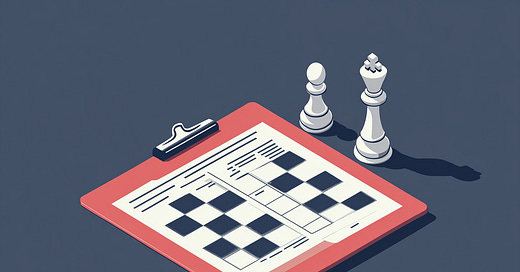Changing how you think during a chess game is hard. If you imagine your chess game as a ship that you’ve built up over many years, trying to make a change can feel like swimming alongside the ship and pushing against the hull. The ship has a lot of momentum and it’s not easy to change its direction.
Nonetheless, in order to improve, you need to change how you think. One way to accomplish this is through the use of a checklist: an explicit list of instructions you follow during the game. The idea is to spell out the thought process you want to be using.
Whenever the idea of a checklist is raised, there are a handful of objections:
It is hard to know what to include in the checklist.
Following a checklist can be annoying or cumbersome.
Top players generally don’t use an explicit checklist.
In this sense, checklists remind me of the famous line about capitalism: it’s the worst economic system, except for all the others. Yes, checklists are awkward and most grandmasters don’t use them, but they can still be an effective tool for changing your thought process.
1 - Address a specific problem. It is tempting to try to create “one checklist to rule them all”: a master checklist that embodies every single thing you should think about during a chess game. But there are a few problems with this.
There are far more things you might want to pay attention to in a chess game than you could realistically include in a checklist. A checklist that included every single thing you might want to think about would be impractically long.
The ideal thought process doesn’t include a checklist. As mentioned before, elite players don’t follow a checklist; they play more intuitively. So by definition, there is no perfect checklist.
Focusing on addressing a specific problem narrows the scope of what you have to deal with. For example, if you observe that you often miss the way your opponent’s move changes the position, you could include in your checklist looking at all the squares that your opponent’s move attacks.
2 - Keep it simple. In order for the checklist to be possible to implement during the game, it can’t have more than a few components. If your ideal thought process is a cathedral, the checklist isn’t the cathedral, it’s the scaffolding. You want to use it to help build one section; then, if all goes well, remove it.
3 - Consider a two-on, one-off approach. This suggestion came from someone on Twitter who works with Esports athletes (sorry, I could not find the tweet to properly credit them). The idea is to do two games where you use the checklist and one where you remove it. If you’re playing online, you could even have a printed checklist next to your computer. The reason for this is that while you want the checklist to guide your attention to something helpful, you don’t want to become reliant on it. With the two-on one-off approach, you’re trying to develop the habit in such a way that eventually you don’t need the checklist.
That’s all I’ve got for today. Have you ever used a checklist approach, and if so, did it improve your chess? What did you include in your checklist?




The tweet was from my friend Kabir Bubna (@KabirBubna) he's doing a PhD on skill acquisition and well worth a follow :)
Having played a recent tournament it became clear that the way I think was consistently the cause of errors during the game. It’s tempting to think that studying tactics, openings and endings is the cure all….but I don’t believe it is.